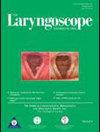Multi-Layered Implant Approach for Hemilaryngectomy Reconstruction in a Porcine Model
Abstract
Objective
Partial laryngectomies result in voice, swallowing, and airway impairment for thousands of patients in the United States each year. Treatment options for dynamic restoration of laryngeal function are limited. Thus, there is a need for new reconstructive approaches. Here, we evaluated early (4 week) outcomes of multi-layered mucosal-myochondral (MMC) implants when used to restore laryngeal form and function after hemilaryngectomy in a porcine model.
Methods
Six Yucatan minipigs underwent transmural hemilaryngectomies followed by reconstruction with customized MMC implants aiming to provide site-appropriate localization of regenerated laryngeal tissues, while supporting laryngeal function. All implants were fabricated from polymeric collagen, with a subset of muscle and cartilage implants containing motor endplate-expressing muscle progenitor cells or cartilage-like cells differentiated from adipose stem cells, respectively. Vocalization and laryngeal electromyography (L-EMG) measurements with nerve conduction studies were performed post-operatively and compared with baseline along with gross and histological analyses of the healing response.
Results
All animals (n = 6) survived and maintained airway patency, safe swallowing, and phonation, without the use of tracheostomy and/or gastrostomy tubes. Histological evaluation indicated no adverse tissue reaction or implant degradation, showing progressive regenerative remodeling with mucosa reformation and ingrowth of new muscle and cartilage. Preliminary L-EMG suggested weak but detectable motor unit action potentials. Although vocalization duration, frequency, and intensity decreased post-operatively, all animals retained vocal capacity and parameter recovery was evident over the study duration.
Conclusion
Engineered collagen polymeric implants in the presence or absence of autologous cell populations may serve as a feasible reconstructive option to restore dynamic function after hemilaryngectomy. Long-term follow-up is needed to further assess functional outcomes.
Level of Evidence
NA Laryngoscope, 135:769–778, 2025


 求助内容:
求助内容: 应助结果提醒方式:
应助结果提醒方式:


